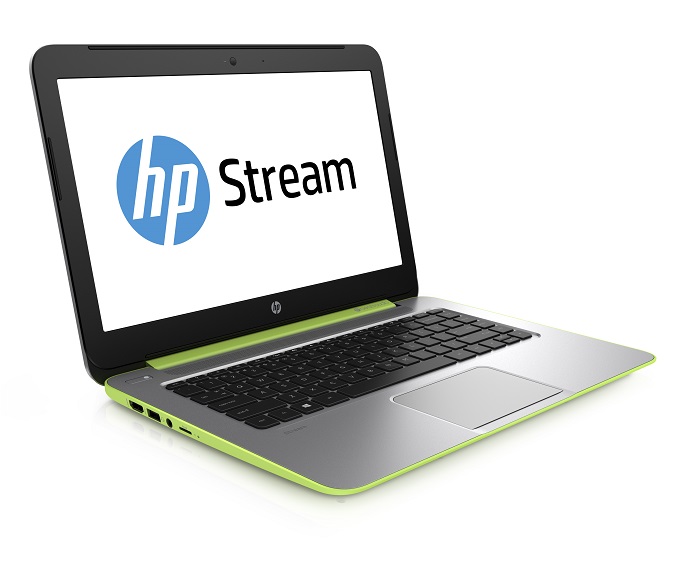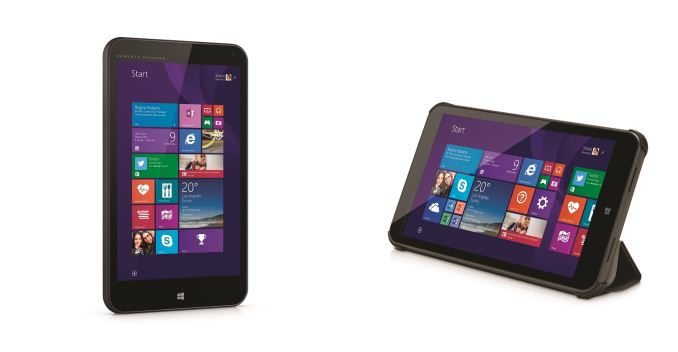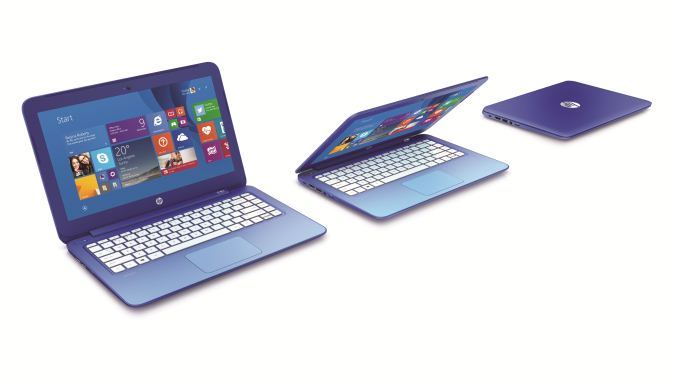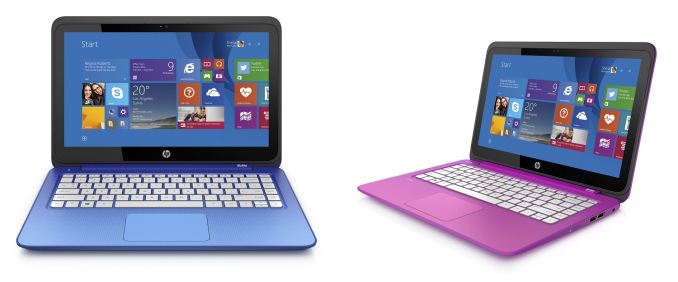HP Announces Low Cost Stream Laptops And Tablets
by Brett Howse on September 29, 2014 11:30 PM EST
Several weeks ago, Hewlet-Packard announced the HP Stream 14” Notebook. The Stream series is HP’s version of the low cost Windows laptop, meant to compete head to head with Chromebooks on price, but still offer the power of a fully fleshed out operating system. The Stream 14 (pictured above) is available to purchase now for only $299, and comes with an AMD A4 APU, 2 GB of RAM, and 32 GB of eMMC storage.
Today, HP revealed the rest of the Stream lineup, with two additional laptops, and two tablets. In a world where the Chromebook has put some serious price pressure on the Average Selling Price of low cost computing, OEMs are trying to win over consumers with nice designs and additional perks in an effort to differentiate from the competition.
First up is the laptops. There are two screen sizes with the smaller being 11.6” and the mid-size being 13.3”, to compliment the already released 14” model. Exact specifications have not been disclosed yet, but both units will be powered by an Intel dual-core Celeron processor based on the Bay Trail architecture. This will make it a fanless device, and both come with 2 GB of RAM and 32 GB of eMMC storage. The 13.3” device has an optional touchscreen to go with the 1366x768 resolution that both laptops share. The 13.3” model also is available with optional 4G connectivity, and as a value add, HP is including 200 MB of free data every month for the life of the device. As another value add, HP is offering one year of Office 365 personal, which includes 1 TB of online storage and 60 Skype minutes per month. Battery life is listed from HP at 8:15 for the 11.6” model, and 7:45 for the 13.3” model. The HP Stream laptops are available in several colors, and will be priced at $199.99 for the 11.6” model and $229.99 as the starting price for the 13.3” model.
With the race to the bottom on pricing, one has to wonder where it will end, but all we know is it has not ended yet. Today HP also announced the HP Stream 7 Tablet, which is a 7” Windows 8.1 with Bing device that comes in at only $99.99. If you are in need of a slightly larger device, with optional 4G, then HP also has you covered with the HP Stream 8 which has a starting price of $149.99. Both tablets are powered by Intel Atom quad-core processors, and 1366x768 screens. Like the larger of the two laptops, the 8” tablet, if equipped with the optional 4G, comes with 200 MB of data per month for the life of the device, and both also come with Office 365 personal for one year. Office 365 personal is $70 to purchase on its own, so for only $30 more you can get it with a 7” tablet.
 HP Stream 7 (left) HP Stream 8 (right)
HP Stream 7 (left) HP Stream 8 (right)
It has been a bit painful to see the thin and light Chromebooks popping up over the last couple of years, and it was always especially frustrating that low cost Windows laptops were large, thick, noisy, and had very slow spinning hard disks. It is great to see the Chromebook styling now coming to Windows PCs, and with the Chromebook pricing as well. Microsoft is making a big push to recapture some of this end of the market by offering Windows 8.1 with Bing, and they are now starting to see some examples of great looking Chromebook competitors.
The tablet side is not as rosy, with Windows 8.1 not having the same mobile ecosystem as Android, but at least the pricing is now in line for the bottom end of the market. The add-ons offered by HP are pretty strong, with the Office 365 Personal costing almost as much as the tablet itself, and 4G for life is a nice bonus to those who just need a bit of data when they are not on Wi-Fi. Of course what the Windows Tablets need as the killer app is the touch version of Office, but that is not available as of yet, so anyone who wants to take advantage of Office 365 will have to do it from a 7-8” desktop, but as with most Windows tablets these can be connected to a keyboard, mouse, and monitor if you were so inclined. This is a strong push by HP to get a foothold in the low end of the market, with sharp looking products and useful value adds as well. Hopefully we can get some of these as review units to give you the full break down on just what you get for so little money.
Source: HP












49 Comments
View All Comments
Brett Howse - Tuesday, September 30, 2014 - link
No, Microsoft held up an HP Stream on state at (I believe) their partner conference in Washington D.C. and said it was going to be $199. Then a 14" version was released for $299 first, but the one held up on state was smaller than that, so therefore it was the 11.6" model which is $199. I don't think there are any conspiracies here - just HP not releasing the entire range on a single day.Brett Howse - Tuesday, September 30, 2014 - link
state=stage not enough coffee when I posted that.IntelUser2000 - Tuesday, September 30, 2014 - link
"The add-ons offered by HP are pretty strong, with the Office 365 Personal costing almost as much as the tablet itself,"Not really from HP. The Office 365 one year license is PART of the Windows + Bing plan. I do like the Stream 8 with LTE costing only $150 though.
BackInAction - Tuesday, September 30, 2014 - link
"It has been a bit painful to see the thin and light Chromebooks popping up over the last couple of years, and it was always especially frustrating that low cost Windows laptops were large, thick, noisy, and had very slow spinning hard disks. It is great to see the Chromebook styling now coming to Windows PCs, and with the Chromebook pricing as well."I'm not sure it was painful, but is nice to see Windows finally ditch the HD and the extraneous storage when neither are needed for these types of devices. I look forward to seeing performance numbers from these. And given that we now have BayTrail Chromebooks, there should be a good head-to-head article in the works.
savagemike - Tuesday, September 30, 2014 - link
But these tablets don't have hdmi output (or SD card for that matter) from what I've read elsewhere. So using that Office subscription on those devices is going to be pretty painful. It's unclear if they are going to support some type of wireless screen sharing. I haven't seen mention of it or full I.D. on the chips used. Not that wireless screen sharing for this kind of purpose has great reviews historically anyway.Does the 365 Personal allow you to install on multiple devices? It might be a nice gimme if you can also install it on an already owned desktop or laptop. Otherwise it seems pretty pointless to include it with 7" and 8" tablets.
On the laptops the Office subscription is a nice bonus. How Microsoft thinks it's going to make money on services when it constantly gives them away I don't know. They'll outright pay you to use Bing to search. It's hard to trip and not get up with Onedrive bonus storage shoved in your pockets. And now the Office365 (likely their only actual money maker overall for these types of services) is being given out like candy. I guess they make it up in volume.
Stephen Barrett - Tuesday, September 30, 2014 - link
OneDrive integrated with Windows 8.1 supports selective sync per file or folder, on-access download and background space reclamation. So you can easily use a 1TB OneDrive with a small storage device as long as you dont try to open a 100GB word document or something similar.savagemike - Tuesday, September 30, 2014 - link
Onedrive does integrate very nicely with modern Windows from what little of it I have tested. Historically Windows tends to balloon itself though. Time will tell if they have nipped this in the bud. Running from compressed files seems to work well enough. I haven't seen much exploration of it but neither have I seen a lot of complaining about speed on devices which I assume to be using it.How it is working in 18 or 24 months is another matter. It's feels wrong to hold the sins of its fathers against modern Windows. But it's also hard to blindly have faith the family trait has been shaken off.
Beyond that Redmond likes to point out how Windows doesn't need the cloud to run. Native apps and native storage and all that are implicit in this campaign. Something like ChromeOS is designed to use onboard storage as nothing more than temporary staging ground for the cloud. You can do otherwise but your shouldering against the designed paradigm. Windows though is a different beast. While Onedrive integration is nice the paradigm is still all about having all your bits on the machine. And that is not gonna play super well with very limited storage.
Wolfpup - Tuesday, September 30, 2014 - link
That's a shame if the tablets don't have SD card slots of some sort...although if they're otherwise good they might still be great cheap tablets.flyingpants1 - Tuesday, September 30, 2014 - link
They were supposed to be $199. And even that's too much.Wolfpup - Tuesday, September 30, 2014 - link
Why is that too much? As compared with what? They're the same price or even cheaper than "Chromebooks" and those things are as crippled as crippled gets. They're priced like other notebooks, but use some flash over a mechanical drive...for some uses they probably make sense (for others not so much...)